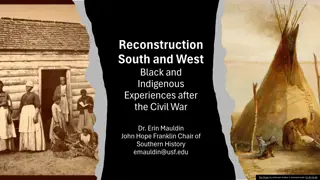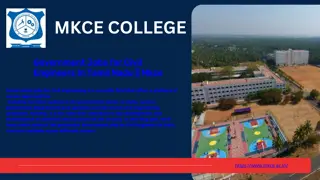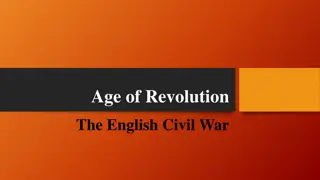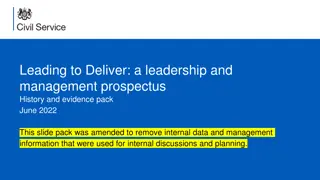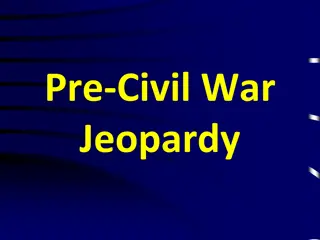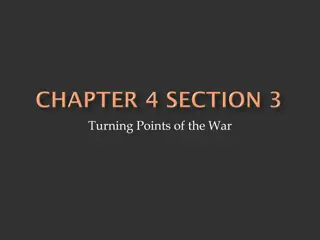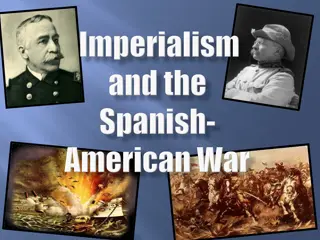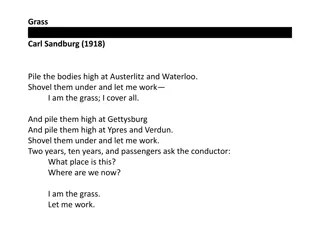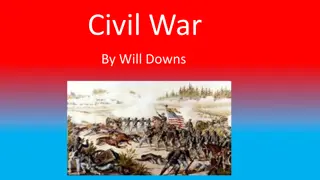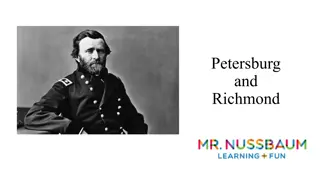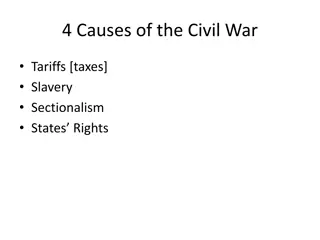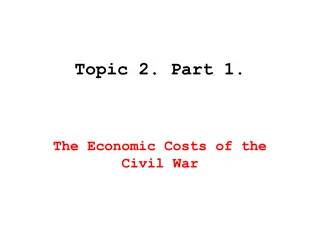The Turning Point: Gettysburg and Vicksburg in the Civil War
President Lincoln issues the Emancipation Proclamation after the Battle of Antietam, setting the stage for significant events in the Civil War. The Union faces leadership changes and Confederate advances, leading to the pivotal Battle of Gettysburg in June 1863. The battle becomes the largest ever fought in the Western Hemisphere, with intense fighting and strategic decisions shaping the outcome.
Download Presentation

Please find below an Image/Link to download the presentation.
The content on the website is provided AS IS for your information and personal use only. It may not be sold, licensed, or shared on other websites without obtaining consent from the author.If you encounter any issues during the download, it is possible that the publisher has removed the file from their server.
You are allowed to download the files provided on this website for personal or commercial use, subject to the condition that they are used lawfully. All files are the property of their respective owners.
The content on the website is provided AS IS for your information and personal use only. It may not be sold, licensed, or shared on other websites without obtaining consent from the author.
E N D
Presentation Transcript
The Turning Point Twin Daggers: Gettysburg and Vicksburg
Where are we in the Civil War? President Lincoln issued the Emancipation Proclamation, following the bloody Battle of Antietam, which freed all slaves in enemy territory. Confederate forces had won decisive victories again the Army of the Potomac at Fredericksburg and Chancellorsville, stopping Federal advances on Richmond. These twin victories exposed major leadership voids in the Union ranks and caused Robert E. Lee to believe his army was invincible. For a second time, Lee endeavored to invade the North. We start in June 1863. We start in June 1863.
1863 After Hooker s disastrous performance at Chancellorsville, Lincoln replaces him as Commander of the Army of the Potomac with George Meade. Lee believed he could threaten the northern cities of Harrisburg, Philadelphia, and even Washington. Lee was desperate to bring suffering to the North, as much of Virginia had been ravaged by war. He also wanted to take advantage of sagging support of the war in the North. George Meade
Late June 1863 Confederate forces head north through Maryland, cross the Mason-Dixon Line and enter Pennsylvania. They are followed by Union forces. Lee s Army reaches Gettysburg, where it proceeds to commandeer a shoe factory. On July 1, fighting begins as Union forces attempt to occupy a series of heights around Gettysburg known as Cemetery Hill, Cemetery Ridge and Culp s Hill. Union forces in and around Gettysburg number over 94,000, with Confederate forces numbering at least. 70,000. Cemetery Ridge
Gettysburg The massive battle will become the largest battle EVER fought in the Western Hemisphere. Violent fighting for control of Gettysburg occurs on July 1 and July 2, resulting in tens of thousands of casualties. Union forces made an incredible stand at the high ground known as Little Round Top, preventing Confederate forces from flanking the Union Army. By Day 3 (July 3), there was no clear winner. Union forces still held the high ground and Lee would make a fateful decision, without the benefit of intelligence usually provided by Jeb Stuart and his cavalry. Where was Jeb Stuart?
Day 3 Lee, desperate to break the stalemate ordered a massive infantry charge up Cemetery Ridge to dislodge Union positions This charge would become known as Pickett s Charge, because it was led by George Pickett s Unit. Confederate General James Longstreet believed it a suicide mission and tried to convince Lee to abandon the plan. Lee would ignore Longstreet s pleas. George Pickett
Picketts Charge 12,000 soldiers under General Pickett began their mile-long advance on July 3, 1863 up Cemetery Ridge after an artillery bombardment, designed to soften defenses. Confederate soldiers made easy targets for Union gunners and artillery, as thousands were killed or wounded. It quickly became apparent that Longstreet was right! Pickett s Charge was a disaster and Lee rode around the ranks shouting it s all my fault, as his soldiers were forced to retreat or were captured. Pickett s unit was decimated. More than half of the 12,000 soldiers were killed, wounded, or captured. He never forgave Lee.
Confederate Retreat Confederate Forces, battered and beleaguered were forced to retreat across the Potomac River, back to Virginia. Although Union General George Meade was credited with winning the epic battle, he was heavily criticized for failing to pursue Lee s exhausted army. Confederate Retreat
Meanwhile in the West Another major tactical goal of President Lincoln was to gain control of the Mississippi River. While Union forces controlled parts of the river, a major section in Mississippi was still controlled by the Confederacy. Vicksburg was a fortified city located high above the bluffs of the river. For several months, Union forces under Ulysses S. Grant had a staged a crippling siege of the city, as direct assaults resulted in thousands of casualties. Controlling Vicksburg was KEY to ultimately controlling the river.
The Siege Took a major toll on the people of the city. Constant bombardment caused people to dig caves in the opposite side of the bluff to survive. Starvation and scurvy plagued the soldiers. Finally, on July 4th, 1863, Vicksburg surrendered to Union forces. The people of Vicksburg refused to celebrate the 4th of July until World War II General Grant
The Effects Union victories on July 3, 1863, at Gettysburg, and July 4th, 1863, at Vicksburg, combined, constituted the turning point of the war. Confederate forces would NOT be able to bring the war to the North, or, achieve foreign recognition. Furthermore, Union forces were now in control of the Mississippi River, which had the effect of isolating Texas, Arkansas, and Louisiana, from the rest of the Confederacy. Lincoln and Cabinet
Activities https://mrnussbaum.com/the-82-year-long-grudge-the-siege-at-vicksburg - his writing prompt describes the grudge the citizens of Vicksburg, Mississippi held against the United States Government after the fall of their city in July of 1863. Independence Day was not celebrated in the Mississippi River town until after World War II. This writing prompt requires students to describe a grudge they have had, or, to describe one in literature, or sports, or if someone has had a grudge against them. https://mrnussbaum.com/forgiveness-a-civil-war-writing-prompt - Following the ill-fated infantry charge known as Pickett's Charge, on the last day of Gettysburg, Confederate Major General George Pickett was said to have harbored a life-long bitterness toward Robert E. Lee, who ordered the charge. This writing prompt requires students to think about the concept of forgiveness and describe the process he or she goes through when deciding whether or not to forgive someone. https://mrnussbaum.com/wanted-a-good-union-general - This is a fun activity that describes the deficiencies of the five commanders Lincoln appointed as Commanders of the Army of the Potomac. Students are required to craft a "Wanted" posted for an effective Union General and to describe the necessary qualities needed for such an important position.
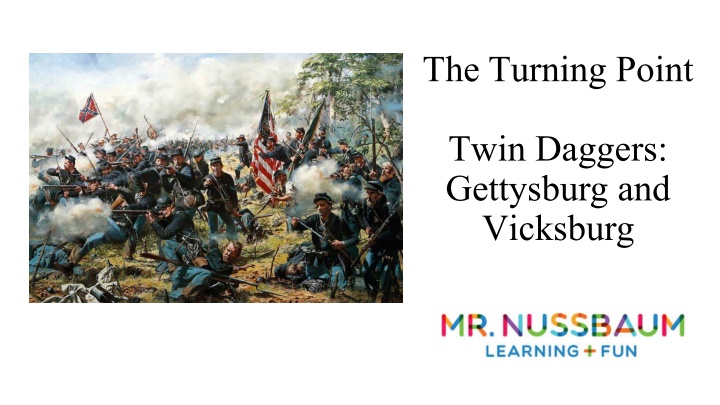

![❤[PDF]⚡ Civil War Talks: Further Reminiscences of George S. Bernard and His Fel](/thumb/20551/pdf-civil-war-talks-further-reminiscences-of-george-s-bernard-and-his-fel.jpg)
